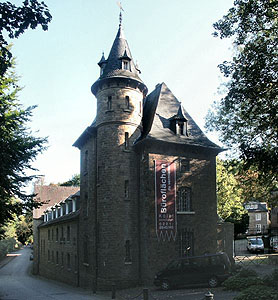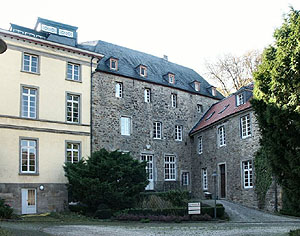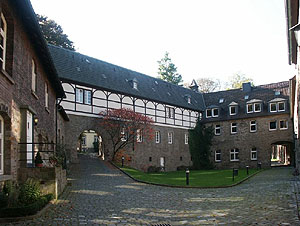Schellenberg Palace

Schellenberg Palace is a well preserved palace on a wooded hill of the Ruhr Heights in the Essen district Rellinghausen, North Rhine Westphalia. Through its exceptional location it is one of the rare examples of a former, high-up situated two-part moated castle. The facility is still under monumental protection.
History of the Residents and Owners
One can't date exactly the first recording of Schellenberg. But historians assume it was in the 12th resp. 13th century as the then owner, the influential family von Broich from Mülheim, was mentioned at that time. (Lit.: Wemmers,Wroblewski, 2001)
The estate came through exchange to the masters von Horst. At that time, the facility was still named Haus opm berge.
Heinrich von Horst sold the then castle in 1353 to Noldo von Kückelsheim, whose granddaughter brought it as her dowry into the marriage with Pilgrim von Leithen in 1388. Their son Dietrich sold the estate in the year 1452 for 1100 Rhenish Gulden to his brother-in-law Johann von Vittinghoff-Schell. Through this family the facility got its present name Schellenberg.
The palace stayed the family's favourite domicile till the 20th century, before they relocated in 1909/10 to the Palace Kalbeck in Weeze.
From then on the palace served as home for the social and clerical organisations, before at the end of the seventies a Höhere Landespolizeischule (state police college) moved in.
When in 1993 the last baron of the Vittinghoff-Schell family died, the whole facility went to Baroness Spieß zu Büllesheim by inheritance.
Construction History
The medieval residential tower with the stone house and the palace-like wing from the 17th century. Picture Copyright : http://de.wikipedia.org/wiki/Bild:SchlossSchellenberg01.jpg

The Main Castle
At the main castle of Palace Schellenberg one can recognise very clearly the different building phases of the facility.
The older buildings are square, four-storey residential tower with the connecting two-storey so-called stone house from the 14th century; both were built with quarrystones. Through the instigation by Johann Vittinghoff-Schell and his wife Frau Agnes Margarethe von Boenen another extension was added 1643-56, to which a smaller palace chapel was attached. These four buildings were probably surrounded in earlier times by a ring wall.
Under Melchior von Vittinghoff-Schell Schellenberg was reconstructed between 1660 and 1672 into a baroque country palace. In the course of the building measures a new wing with corner towers were added in a right angle onto the residential tower and the stone house was modernised.
Also at the same time (1670) the chapel was raised by another storey. In addition it received a curved hood with lantern. In the same year a smaller wing was added to the residential tower.
Max Friedrich von Vittinghoff-Schell and his wife Countess von Spee Heltorf built from 1820 onwards a three-storey manor at the south side of the facility. To create enough space for this building the still existing moat had to be filled in. Nine years later the medieval stone house was raised and received a joined roof with the residential tower.
The first demolishing of older building parts happened already in 1879 but in 1893 a new two-storey annex with corner towers in neo-gothic style were added at the residential tower's north side.
Last but not least the neo-gothic gate house was created in the course of reconstruction in 1875 in the castle romantic style.
Follow-up building activities only took place till the present time but only inside the building.
Picture Copyright : http://de.wikipedia.org/wiki/Bild:SchlossSchellenberg05.jpg

The Farm Estates
East of the palace two expansive farm estates are situated, of which the so-called inner farm was built on the foundations of the medieval barbican from the 14th century. First the baroque treasury was constructed from 1643 to 1653 as stone and half-timbered building and enlarged in 1672 by a wash house. In the first quarter of the 19th century a baking house was added. The long-stretched outer farm was built later from 1804 onwards.
The Palace Park
Schellenberg is surrounded on two sides by the large palace park, whose present form goes back to the first half of the 19th century. But its origin can be found in a baroque garden from the 17th century.
There is a baroque pleasure pavilion from the year 1674 situated in the park.
Picture Copyright :http://de.wikipedia.org/wiki/Bild:SchlossSchellenberg04.jpgThis article is based on the article http://de.wikipedia.org/wiki/Schloss_Schellenberg from the free Encyclopedia Wikipedia and is under http://de.wikipedia.org/wiki/GNU-Lizenz_f%C3%BCr_freie_Dokumentation . In Wikipedia is a http://de.wikipedia.org/w/index.php?title=Schloss_Schellenberg&action=history available.

